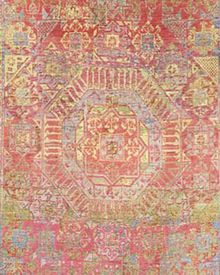Egyptian Carpet
| Egyptian Carpet | |
|---|---|
 | |
| General information | |
| Name | Egyptian Carpet |
| Original name | فرش مصر، قالی مصر |
| Alternative name(s) | Egyptian Rug |
| Origin | |
| Technical information | |
| Common designs | Geometric |
| Pile material | Wool |
| Foundation material | Wool |
| Knot type | Symmetrical (Turkish) |
Egyptian Carpet or Egyptian Rug is one of the western rugs that woven in Egypt.
A bed cover with symmetrically knotted linen pile was found in the tomb of Kha and dated to 1400 b.c.e. Cut pile rugs were woven in Egypt as early as the pre-Islamic period, in the sixth century. Heavy tapestry weaves were produced in Fustat in the ninth century. The greatest period of Egyptian carpet weaving was during the reign of the Mamluks, when brightly colored rugs with complex geometric designs were woven in Cairo beginning in the latter part of the fifteenth century. In the sixteenth century, after the Turkish conquest (1517), rugs were woven in Cairo in Ottoman designs. By the late seventeenth century knotted rug production had all but disappeared.
Due to limitations on imports, knotted rug production began again in the 1950s. There is no significant export of these rugs made in Persian, Turkish, and Caucasian designs. Knot counts in contemporary Egyptian rugs are expressed as 4 x 5, where the first number is knots per centimeter weftwise and the second number is knots per centimeter warpwise. Thus, 4 x 5 is 20 knots per square centimeter.[1]
History
Egypt is a country located in eastern North Africa that possesses a weaving history that dates to before the Common Era. Examples of Egyptian tapestries and fiatwoven mats have survived from 1500 BCE.
Pile rugs from the seventh to eleventh centuries CE were made in Fustat, near Cairo, and the port town of Quseir Al-Quadim. Fustat examples are preserved in institutions such as the Benaki Museum in Athens and the Fine Arts Museums of San Francisco, and are held in private collections.
Beginning in the fourteenth century the Mamluk court produced carpets with asymmetric knots, wool foundations, and wool piles. These weavings were made for Mamluk rulers to decorate palaces and for export abroad. Mamluk carpets are greatly appreciated in the worldwide antique market. A one-of-a-kind, exceptional Mamluk silk pile carpet made in Cairo during the first half of the sixteenth century is preserved in the Museum of Applied Arts in Vienna.
During the sixteenth century the Ottoman Empire conquered and occupied Egypt and rapidly expanded the carpet-producing industry. Egyptian weaving artisans and supervisors were forcibly removed to cities such as Damascus, Syria, and the Ottoman capitol of Istanbul to develop carpet weaving industries. There they produced rugs and carpets for the empire's needs and the worldwide market. These weavings are charming in design and coloration.
Under the occupation of the Ottomans, Cairo weavers developed the well-known Cairene carpet style. It had design influences from Anatolia (Turkey), Egypt, and Persia. Cairene carpets, also called "Ottoman" carpets in the trade, were made in room sizes and palace dimensions for the Ottoman court and foreign export. Some of these carpets were commissioned in circular or other formats, as well as long and narrow gallery sizes reaching thirty-five feet in length.
By the nineteenth century the carpet weaving industry in Egypt had slowed because of low demand in the world market. Egypt revived the industry in the 1950s by making reproductions of traditional Persian carpets from such cities as Isfahan, Kashan, Kerman, and Tabriz. These classic designs were in demand during this period. Popular decorative styles continued to be made for the world market through the 1970s. Egyptian weavers reproduced Oriental designs from Sultanabad and Serapi in Iran, and from Amritsar in India. These styles are still fashionable today and are in demand by decorators and consumers.
Egypt today is an active Oriental rug supplier to the world market. The quality of recent Egyptian carpets ranges from medium to fine in grade. The dimensions range from approximately nine feet by six feet to oversize living room formats. A small percentage of scatter rugs up to six feet by four feet and runners are also made.[2]
References
Bibliography
- Abraham Levi Moheban. 2015. The Encyclopedia of Antique Carpets: Twenty-Five Centuries of Weaving. NewYork: Princeton Architectural Press.
- Peter F. Stone. 2013. Oriental Rugs: An Illustrated Lexicon of Motifs, Materials, and Origins. North Clarendon: Tuttle.